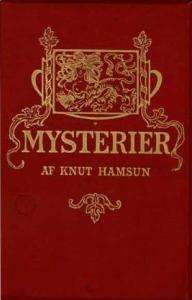Mysteries (novel)
Mysteries (Norwegian: Mysterier, 1892) is the second novel by Norwegian author Knut Hamsun.
 First edition cover | |
| Author | Knut Hamsun |
|---|---|
| Original title | Mysterier |
| Translator | Gerry Bothmer |
| Country | Norway |
| Language | Danish |
| Genre | Psychological novel |
| Publisher | Gyldendal Norsk Forlag Farrar, Straus and Giroux Penguin Classics |
Publication date | 1892 (Norway) 1971 (USA) |
| Media type | |
| Pages | 352 |
| Preceded by | Hunger |
| Followed by | Redaktør Lynge |
Plot
The community of a small Norwegian coastal town is shaken by the arrival of eccentric stranger Johan Nagel, who proceeds to shock, bewilder, and beguile its bourgeois inhabitants with his bizarre behavior, feverish rants, and uncompromising self-revelations.[1][2]
Publication
The novel was originally published in Norwegian in Norway in 1892. It was translated into English by Gerry Bothmer and published by Farrar, Straus and Giroux in 1971, with an afterword by Isaac Bashevis Singer, who said, "The whole school of fiction in the 20th century stems from Hamsun."[3] Mysteries is said to have "the shape and spirit of the modern novel, produced at a time when the modern novel did not yet exist".[2]
The novel inspired Paul Juon to write his tone-poem for cello and orchestra, "Mysteries" op.59, written in 1914 and published in 1928. [4]
References
- James Wood, "Addicted to Unpredictability," London Review of Books, Vol. 20, No. 23, November 26, 1998.
- Jeffrey Frank, "In From the Cold," The New Yorker, December 26, 2005.
- Walter Gibbs, "Norwegian Nobel Laureate, Once Shunned, Is Now Celebrated," New York Times, February 27, 2009.
- "Nordic Brevity Meets Unknown Russian Symphony from Late 1930s : Seen and Heard International". Retrieved 2020-04-24.